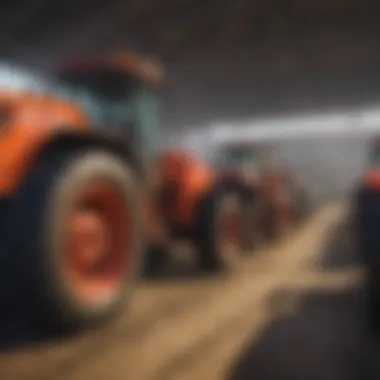Understanding the Polk Farm Equipment Auction


Intro
The Polk Farm Equipment Auction serves as a vital platform within the agriculture sector. This event is not just a marketplace; it reflects the ongoing dynamics of the agricultural economy. Farmers, equipment dealers, and enthusiasts congregate to exchange not just machinery but also ideas and knowledge, making it a key event for anyone involved in modern farming.
Understanding the nuances of this auction can enhance one's ability to make informed decisions, whether you are a seasoned farmer or a newcomer exploring the agricultural field. Throughout this article, we will explore the essence of the Polk Farm Equipment Auction, its advantages, and strategies to navigate the auction process effectively.
Key Concepts and Terminology
Basic Definitions
Before delving deeper, it is essential to establish some basic concepts regarding the auction. An auction is defined as a process where goods or services are sold to the highest bidder. In the context of farm equipment, auctions can include various types of machinery, such as tractors, plows, and harvesters. Each item generally comes with a description, including its functionality and estimated market value.
Historical Context
Auctions for farm equipment have a history that dates back many decades. Initially, these events were local gatherings where farmers exchanged outdated machinery for newer models. This tradition is still alive today, but it has evolved significantly. The introduction of online bidding platforms and the rise of technology have transformed how these auctions are conducted. Understanding the historical backdrop offers insight into how current practices have emerged.
Recent Innovations and Trends
Technological Advancements
Technology plays a crucial role in changing the landscape of farm equipment auctions. For instance, software such as Farmer's Edge and AuctionTime allows potential bidders to view equipment specifications, historical pricing, and even current market trends. This data helps buyers make educated decisions instead of relying solely on gut feeling.
Sustainable Practices
The agricultural sector is increasingly focusing on sustainability. Many auctions now feature equipment that promotes environmentally friendly practices. For example, more sellers are listing equipment that reduces fuel consumption and improves soil health. Participation in these auctions presents an opportunity for farmers who prioritize sustainable farming methods.
Practical Applications and Techniques
Step-by-step Guides
- Research Before the Auction: Knowledge is power. Understand the types of equipment you are interested in and their market values to prevent overbidding.
- Set a Budget: Determine a clear budget before the auction. This ensures your spending aligns with your financial situation and prevents impulse buys during the competitive bidding process.
- Inspect Equipment: Whenever possible, inspect equipment personally. Look for signs of wear and tear and ask sellers pertinent questions. Understanding the condition of the equipment can save money in the long run.
- Use Online Resources: Platforms like auctionzip.com offer insights into upcoming auctions, equipment listings, and previous sale prices. Utilize these tools to stay informed.
Case Studies
Consider the case of John, a farmer who attended the Polk Auction last year. By conducting thorough research prior, he managed to acquire a used John Deere tractor for significantly below market value. His ability to see the machinery up close allowed him to avoid potential pitfalls, proving that preparation is key.
"An informed farmer is an empowered farmer. Understanding trends and utilizing technology are fundamental to success in today's agriculture." — Agricultural Expert
Overview of Polk Farm Equipment Auction
The Polk Farm Equipment Auction holds significant relevance in the agricultural community. It serves as a platform where farmers and agricultural businesses can buy and sell a variety of farm machinery and tools. This auction is not just a transaction point; it is a crossroads of innovation and tradition, reflecting the ongoing evolution of farming practices.
Historical Context
Historically, auctions have been a cornerstone for farmers looking to acquire or liquidate assets. The Polk Farm Equipment Auction has roots that intertwine with the agricultural development in the region. Initially, auctions were simple gatherings where local farmers exchanged equipment they no longer needed. Over time, this evolved into a more organized event with broader participation. It became a staple in the farming calendar, signaling a time for renewal and adaptation in equipment usage. Many farmers rely on such auctions as part of their yearly planning, making it essential to understand the historical landscape that shaped today's auction culture.
Current Trends in Equipment Auctions
Currently, the landscape of farm equipment auctions is influenced by various trends. First, the integration of technology plays a crucial role. Online bidding platforms have emerged, allowing wider access and participation. Farmers now have the option to bid from anywhere, which increases competition and often drives up auction prices.
Moreover, there is a growing emphasis on sustainability. As concerns about environmental impact rise, many buyers are looking for equipment that supports sustainable practices. Auctions are adjusting to these shifts, presenting a range of machinery that fits the modern farmer's needs. Understanding these trends is vital for anyone looking to engage in the auction, whether they are buying or selling.
Types of Equipment Available
The Polk Farm Equipment Auction serves as a vital marketplace for various agricultural machinery and tools. Understanding the types of equipment accessible at this auction is essential for participants. It gives insights into what to expect, what value to find, and how to optimize purchases. The range of equipment can affect farming operations significantly. Thus, attendees need to be familiar with available options and their respective benefits.
Tractors


Tractors are often the centerpiece of farm auctions. They serve multiple functions, making them essential for any farm operation. Various models and brands can fit different needs. Some farmers might require compact models for smaller plots, while others may seek the heavy-duty versions for larger fields. The versatility of tractors allows them to pull, push, or carry heavy loads efficiently. When attending the auction, it's vital to assess tractor conditions and specifications, including horsepower, attachments, and fuel type.
Harvesting Machinery
Harvesting machinery is crucial for collecting crops once they are ready. This equipment can range from combine harvesters to specialized units for specific crop types. Owning high-quality harvesting machinery can translate to increased efficiency and reduced labor costs. Participants should research the machinery's capabilities, maintenance history, and the types of crops it handles. Bidding on harvesting machinery requires thorough attention to detail to ensure it matches the operational needs.
Tillage Equipment
Tillage equipment is another key category at auctions. Items in this segment include plows, cultivators, and harrows. These tools prepare the soil for planting, impacting future crop yields. Different brands may offer varying innovations in soil management. Bidders should consider their soil type and farming methods when assessing options. Additionally, understanding how to maintain and operate tillage equipment can affect long-term productivity on the farm.
Irrigation and Planting Tools
Efficient water management is an integral part of farming. Irrigation and planting tools at the auction can include drip systems, sprinklers, and seeders. Investing in high-quality equipment can lead to better crop yields and resource management. Participants should evaluate the features of these tools, such as water delivery methods and compatibility with existing systems. Understanding the importance of irrigation and planting tools can lead to productive farming seasons.
The Auction Process
The auction process serves as a critical component of the Polk Farm Equipment Auction. Understanding this process helps participants make informed decisions and increases their chances of securing quality equipment at competitive prices. It encompasses various steps that need careful consideration, including preparation, bidding strategies, and post-auction actions. This section provides an essential overview, helping both experienced farmers and newcomers grasp the intricacies involved in the auction environment.
Preparation for the Auction
Preparing for the auction is possibly the most crucial phase. It is vital to research all available equipment in advance. This includes reviewing condition reports and historical sale prices for similar items. Each piece of equipment has its own unique value based on age, condition, and usage history. Errors in preparation can lead to oversights that might cost the bidder significantly.
A good practice is to visit previous auctions to observe the process. This helps in understanding the pace of bidding and the type of equipment that is frequently sold. Additionally, make sure to register early. Some auctions require registration before the day of the event.
Furthermore, familiarize with the auction terms. Different auctions might have unique rules regarding payment, returns, and warranties. Know exactly what forms of payment are accepted.
"Knowledge and preparation are key to minimizing risk and maximizing opportunity at auctions."
Bidding Strategies
Bidding strategies are varied, and the right approach can differ from one auction to another. One effective strategy is to set a maximum bid amount before the auction starts. This helps maintain discipline and prevents emotional bidding, which often leads to overpayment. It is also important to stay calm and composed during the bidding process. Observing the room may reveal bidding patterns, such as when a competitor seems to drop out.
Consider using a bidding increment strategy, where the bidder increases their bids by predetermined amounts to gauge interest from other bidders. This deliberate method can help in determining when to initiate a higher bid.
Some attendees may also find success in collaborating with other farmers to share insights. While not formal partnerships, a conversation with fellow bidders can clarify expectations and help track the bid landscape.
Post-Auction Considerations
The time after the auction concludes is just as critical as the previous steps. Buyers should thoroughly inspect their acquired equipment immediately after winning the bid. Check for any discrepancies between the auction description and the actual condition of the equipment. If issues arise, document them timely as this insures you have proof in case of disputes.
Payment must be made promptly, according to the auction terms. Failing to adhere to payment protocols can result in penalties or loss of the equipment. If planning to transport the equipment home, evaluate logistics and ensure everything required for safe transport is arranged in advance.
Lastly, engage with the auctioneer for additional offers. Sometimes, there might be opportunities for ancillary purchases such as attachments or other tools that can enhance your newly acquired equipment.
Valuation of Equipment
Valuation of equipment plays a crucial role in the Polk Farm Equipment Auction. As it directly influences bidding behavior, understanding how equipment is valued can lead to more informed purchasing decisions. In the context of the auction, which sees a range of machinery and tools, having clear knowledge about what contributes to the worth of each item is vital. This section will outline the specific elements that impact valuation, exploring benefits and practical considerations for participants.
Factors Influencing Price
There are several factors that can affect the price of farm equipment at auctions. Firstly, age of the machinery is significant. Generally, newer equipment commands a higher price due to advancements in technology and efficiency. However, vintage equipment can sometimes draw higher bids depending on its desirability among collectors or specific agricultural niches.
Secondly, brand reputation also plays a part. Well-established brands like John Deere or Case IH are often perceived as more reliable, thus their equipment may fetch higher prices.
Additionally, market demand significantly dictates how much a buyer is willing to spend. If there is a surge in interest for a specific type of machinery—like advanced tractors with GPS technology—prices may increase correspondingly.
Lastly, seasonal fluctuations can influence pricing. For instance, during the planting season, demand for planting equipment will spike, potentially driving up auction prices.


Condition and Longevity
The condition of the equipment, assessed during the auction preview, is paramount in its valuation. Buyers typically evaluate the external and internal state of machinery. Factors such as wear and tear, maintenance history, and any signs of rust or damage can drastically alter the perceived value of an item.
Longevity is another aspect to consider. Well-maintained equipment that has a reputation for durability can often command higher prices. Buyers may compare the hours of usage to gauge how much life is left in the machinery. Buyers are less inclined to invest in equipment that might require immediate repairs or replacements. Understanding these aspects can significantly impact purchase decisions and bidding strategies during the auction.
Market Comparisons
Analyzing market comparisons is essential for accurate valuation. Participants should research recent sale prices of similar equipment to establish a reasonable benchmark. Online resources and auction results can help in understanding typical pricing trends for specific machinery. By reviewing these comparisons, bidders can better estimate what is a fair price for an item they are interested in.
Furthermore, understanding the local market conditions in their area helps buyers gauge the demand and adjust their bidding limits accordingly. For instance, if a region is agricultural-heavy and requires specific machinery type, it might shift the expectations for pricing at the auction.
In summary, valuation of equipment during the Polk Farm Equipment Auction is complex, yet understanding these elements can greatly enhance buyers' confidence and help them make smarter investments.
Benefits of Participating in Auctions
Participating in auctions, specifically the Polk Farm Equipment Auction, presents a range of benefits crucial for both farming professionals and enthusiasts. Understanding these advantages can enhance the auction experience, allowing participants to make informed decisions. Key elements to consider include access to diverse equipment, cost-effective purchases, and opportunities for networking.
Access to Diverse Equipment
One significant advantage of participating in auctions is the access to a wide range of agricultural equipment. From tractors to irrigation systems, the array of machinery available caters to various farming needs. This diversity allows farmers to explore different brands and models without the limitations often found in retail settings. It also enables buyers to find specialized equipment that may not be readily available in the market.
- Variety: Auctions often feature both new and used equipment, enabling buyers to choose based on their budget and preferences.
- Unique Finds: Attendees can discover rare or vintage items that can enhance their farm's capabilities.
This access broadens the horizon for farmers, making it easier to update their machinery and adopt new technologies critical for modern agriculture.
Cost-Effective Purchases
Cost efficiency is another compelling benefit of auctions. Typically, auction prices can be lower than retail price tags, allowing participants to secure equipment at a fraction of the cost. Below are points explaining why auctions can be a financially sound choice:
- Bargaining Potential: The competitive nature of auctions may drive prices down, leading to better deals.
- Avoiding Premiums: Unlike traditional retail, auctions don't include additional costs like overhead, which keeps prices lower.
- Flexible Bidding: Participants can set a budget and bid accordingly, enhancing financial control over purchases.
This opportunity to save can significantly impact the overall farm budget, making it easier for farmers to invest in other essential areas.
Networking Opportunities
Another often overlooked benefit of farm equipment auctions is the potential for networking. Auctions serve as a gathering place for individuals within the agricultural sector, including farmers, dealers, and service providers. Building connections in this environment is invaluable.
- Industry Insights: Engaging with other attendees provides insights into industry trends and technologies.
- Partnerships: Networking could lead to partnerships, collaborations, or mentorships, beneficial for both novice and experienced farmers.
- Peer Learning: Sharing experiences with fellow attendees enhances knowledge about equipment and farming techniques.
Networking not only enriches individual knowledge but also fosters a sense of community within the agricultural sphere. This can lead to long-term benefits beyond the auction itself.
"Auctions not only open doors for acquiring equipment but also for forming essential connections within the agricultural community."
Challenges in Equipment Auctions
Participating in equipment auctions can be a beneficial experience for farmers and agricultural enthusiasts, but it does not come without its challenges. Understanding these challenges is critical for anyone looking to navigate the auction landscape successfully. The aspects of risk, limited warranties, and emotional factors can significantly influence the auction experience and should not be underestimated.
Risk of Overpaying
One of the primary concerns during an auction is the risk of overpaying for equipment. This phenomenon can occur when bidders get caught up in the competitive atmosphere. Factors such as excitement or the desire to secure a particular piece of machinery can lead to irrational bidding behavior.
Several strategies can help mitigate this risk:
- Set a clear budget: Knowing your financial limits prior to the auction can keep bidding in check.
- Do your research: Familiarize yourself with the average market values for the equipment you are interested in.
- Stay calm: Keeping emotions in check can be crucial when bids begin to escalate.
"Understanding the value of equipment can help prevent overpaying, which is a common trap during auctions."


Limited Warranty Options
Another challenge in auctions is the limited warranty options available for purchased equipment. Unlike retail purchases, items won at auctions often come with little to no extended warranty support. This can leave buyers vulnerable if the equipment breaks down shortly after purchase.
Potential solutions for this issue include:
- Inspect equipment thoroughly: Take time to examine and test equipment before placing a bid. Knowing the condition of the machines can save future headaches.
- Ask questions: Engage with sellers to understand any warranties or conditions associated with the equipment, if applicable.
- Consider post-auction inspections: Some auction companies may offer post-auction inspection services for an added layer of security.
Emotional Bidding
Emotional bidding is a significant challenge that auction participants must navigate. The environment at an auction can become highly charged, causing bidders to focus more on emotions than rational decision-making. When individuals feel a strong connection to a piece of equipment or are driven by competition, they may bid more than they had planned.
To counteract emotional bidding:
- Establish a bidding plan: Stick to your predetermined strategy and budget, regardless of the environment.
- Focus on long-term needs: Rather than getting caught up in momentary desires, consider how the equipment will fit into your overall operation over time.
- Breathe and refocus: If you feel yourself overwhelmed, take a moment to step back and reassess your strategy.
By acknowledging these challenges and strategizing accordingly, participants can enhance their auction experience, making informed decisions rather than falling prey to impulse.
Tips for First-Time Auction Attendees
Participating in an auction for the first time can be both exciting and nerve-wracking. It's essential to understand that a well-prepared attendee can maximize their chances of making successful purchases while minimizing potential risks. Here are key points tailored for individuals new to the Polk Farm Equipment Auction, focusing on the preparatory steps that will prove beneficial.
Researching Before Bidding
Before attending the auction, comprehensive research is crucial. Familiarize yourself with the types of equipment typically available. For instance, understand the specifications of tractors, harvesting machinery, and irrigation tools that might interest you. Websites like Wikipedia offer foundational knowledge about auctions in general, while forums on platforms such as Reddit can provide insights from experienced buyers.
In addition to equipment types, explore auction history and previous sales trends. Knowing what similar items sold for in past auctions can help you gauge fair prices. Also, take note of potential auctioneers. Each auction house may have different reputations and methods of operation.
Setting a Budget
Establishing a clear budget is vital. First-time auction attendees should determine an upper limit that they are comfortable with before the event. This budget should consider not only the purchase price of equipment but also additional costs such as bidding fees, transportation, and potential repairs. By doing so, participants can avoid the pitfall of overbidding, which is common in auction settings.
It is advisable to use a simple formula: take into account the current market rates, your financial situation, and the importance of specific equipment to your operations. A well-defined budget can also help you stay disciplined during the bidding process.
Understanding the Auctioneer's Process
Gaining a solid grasp of how the auctioneer operates is vital for effective participation. Each auctioneer has their unique style and methods of conducting bidding. Observe how they present items, set starting prices, and interact with bidders. This understanding can enhance your bidding strategy and improve communication.
Familiarize yourself with the terms of the auction, including any reserved prices and the timeframe allotted for each lot. Auctions can move quickly, and knowing when to bid can make a significant difference in securing desired items. Don’t hesitate to ask staff for clarification on the process if any elements appear confusing.
Ultimately, first-time attendees should approach auctions with a strategy rooted in preparation. By researching before the event, setting a prudent budget, and understanding the auctioneer's process, participation can be more rewarding and less stressful. > \n
"Preparation is the key to success—especially when dealing with auctions."
Taking these steps will not only enhance your experience but also position you favorably for making informed decisions and securing valuable farm equipment.
Ending
The conclusion serves as a critical synthesis of the various elements discussed throughout the article. Understanding the Polk Farm Equipment Auction is not merely about the bidding process or available equipment; it is also about grasping the broader implications for agricultural practitioners and enthusiasts.
Future of Equipment Auctions
In the rapidly evolving agricultural landscape, the future of equipment auctions appears bright yet challenging. Technology's integration into the auction world is accelerating. Online auctions are becoming more prevalent, allowing a wider audience to participate. This digital shift offers convenience but also increases competition.
Emerging technologies, such as drones and IoT devices, may also change the types of equipment available. Farmers will likely seek out advanced machinery that can enhance productivity and yield. Consequently, auctioneers must adapt to these trends, continually updating their offerings.
Moreover, environmental considerations are becoming significant. Buyers are increasingly looking for sustainable and efficient equipment. This shift might influence the valuation of machinery that meets eco-friendly standards. Associations and farms that embrace sustainability could find themselves ahead in the auction bidding wars of the future.
Final Thoughts
Bidders should be mindful of the auction process, from preparation to post-auction evaluations. By applying the insights and tips shared in this article, participants can navigate the complexities of the auction successfully. Therefore, understanding the auction ecosystem is crucial for maximizing investments and securing the right equipment.
"The key to successful bidding lies not just in the competition but in informed decision-making and strategic planning."
In summary, the Polk Farm Equipment Auction represents a valuable intersection of tradition and innovation, offering essential resources for the future of farming.















